| Columns Retired Columns & Blogs |
InnerSound Eros Mk.III electrostatic loudspeaker Measurements
Sidebar 3: Measurements
I looked first at the InnerSound Eros Mk.III's electronic crossover, but was initially stymied by my inability to get any signal from its low-pass (woofer) outputs. I consulted the manual, which was no help, and it was only several days later, with the loan of a second sample from Brooklyn-based photographer Wes Bender, that I realized what I was doing wrong. Other than the Level control, the crossover's controls—marked Bass and Midrange—both affect only the woofer. As I had the Midrange control set to "0," the woofer was effectively turned off.
Fig.1 shows the crossover's woofer output with the Midrange control operated in steps of 10 from an indicated "60" to "99." The shape of the curve doesn't change, only the absolute level; thus, the Midrange control actually acts as the woofer-level control, the number displayed representing the gain in dB above a nominal reference. The unity-gain setting for high-pass (at 1kHz) and low-pass (at 100Hz, Midrange set to "90," Bass set to "12") line outputs appeared to be "90" and "89," respectively. To minimize the possibility of clipping the outboard power amplifier, the Eros crossover's settings should only be increased above this with care. The low-pass power amplifier offered 27.4dB of voltage gain at 100Hz into 8 ohms at this setting, which will match the sensitivity of many third-party amplifiers.
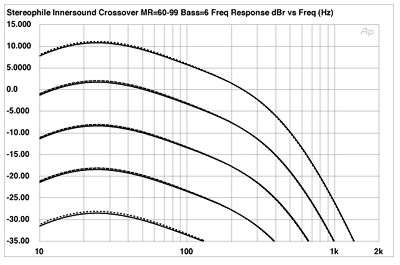
Fig.1 InnerSound Eros Mk.III crossover, Bass = "6," low-pass frequency response with Midrange = "60" (bottom) to "90" (top). (5dB/vertical div.)
Fig.2 shows the high-pass output (right), revealing some shaped boost in the drive signal to the panel between 450Hz and 8kHz, with a steep, 24dB/octave rolloff below that region. To the left of fig.2 is shown the effect of the Bass control with the Midrange set to "90." The lowest trace is with the Bass control set to "0"; each successively higher trace was taken with an increase of "3" in the numeric reading, with the top trace equivalent to "12." The control can be seen to affect the level of the entire bass region below 300Hz. In combination with the Midrange control, the Bass control should allow an optimal match to be obtained between the panel and woofer outputs and the room acoustics.
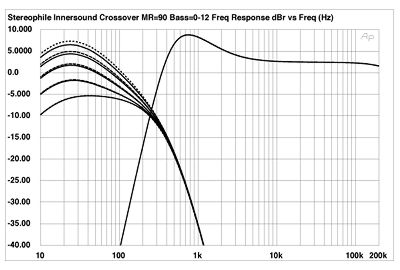
Fig.2 InnerSound Eros Mk.III crossover, Level = "90," Midrange = "90," Bass = "6," high-pass frequency response (right) and low-pass frequency response (left) with Bass = "0" (bottom) to "12" (top). (5dB/vertical div.)
The crossover's input impedance at 1kHz was a usefully high 49k ohms unbalanced or 85k ohms balanced. The line-output source impedance depended on frequency, filter section, and whether it was balanced or unbalanced. The unbalanced high-pass (panel) output impedance was a moderate 480 ohms over most of the audioband, rising slightly to 716 ohms at 200Hz. The balanced figures were just under twice the unbalanced, but as long as an amplifier is used with an input impedance of at least 10k ohms, there will be no matching problems. The low-pass line-level output features quite a high source impedance, at 1280 ohms unbalanced and 1580 ohms balanced at 100Hz, rising to 7k ohms at 20Hz. In the unlikely event that the user wants to use a separate woofer amplifier with the Eros, it should have an input impedance approaching 100k ohms. The Eros crossover's amplifier impedance was a healthily low 0.12 ohm.
The high-pass output features low levels of noise and distortion. The spectrum shown in fig.3 was taken with the crossover's unbalanced output driving 1kHz at 1V into 8k ohms. The second harmonic is the highest in level, but at -102dB (0.0008%), this won't upset anyone. With its gain set to "90," the high-pass output could deliver enough output to drive the partnering amplifier into clipping (fig.4). Peculiarly, though the maximum output voltage was curtailed into 600 ohms, as expected, this load actually resulted in lower levels of noise and distortion than the more benign 100k ohm load. The low-pass amplifier also gave low levels of noise and distortion, up to its clipping point (fig.5). The amplifier met its 600Wpc specification to 4 ohms (24.8dBW), with 380W available into 8 ohms (25.8dBW), both figures at 1% THD.
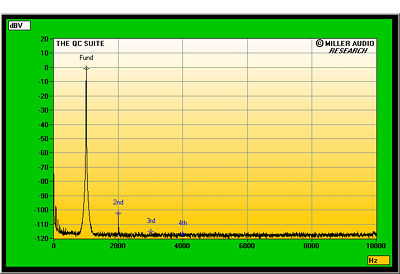
Fig.3 InnerSound Eros Mk.III, unbalanced high-pass output, spectrum of 1kHz sinewave, DC-10kHz, at 1V into 8k ohms (linear frequency scale).
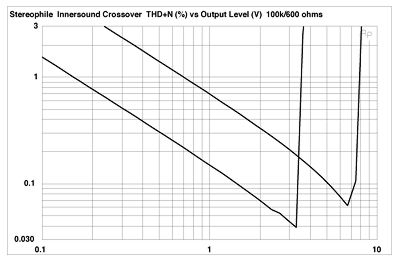
Fig.4 InnerSound Eros Mk.III crossover, high-pass balanced output, distortion (%) vs 1kHz output voltage into 100k ohms (top) and 600 ohms (bottom).
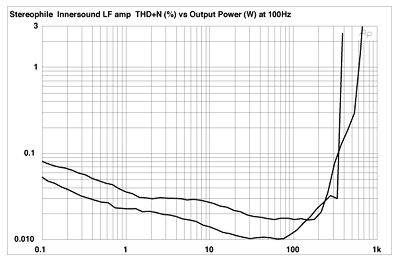
Fig.5 InnerSound Eros Mk.III crossover, low-pass amplifier, distortion (%) vs 100Hz output power into 4 ohms (top) and 8 ohms (bottom).
I then turned to the speaker itself. With its crossover level control set to the unity-gain setting of "90," its B-weighted sensitivity was around 88dB(B)/2.83V/m, which is above-average for an electrostatic design. However, as can be seen from the panel's impedance plot (fig.6, upper trace), it draws very little current from the amplifier, hence almost no power. The panel's impedance stays above 50 ohms between 90Hz and 1.8kHz, reaching a maximum value of 137 ohms at 490Hz. (Note also the small spike at 86Hz, which is probably due to the panel's fundamental "drumskin" tuning resonance.) However, the panel's impedance drops rapidly above 2kHz, and is compromised by a severely capacitive phase angle over much of the treble region.
The impedance actually drops to a minimum of 0.6 ohm at 35kHz, which is probably just the series resistance of the connecting wire. Fortunately, the phase angle at this frequency is 0 degrees! Possibly the worst-case condition is at 18kHz, where the magnitude is still low at 3.2 ohms but the phase angle is -79 degrees. Musical energy is unlikely to be very high in this region, but some amplifiers will not like driving this kind of load—where the current is at its greatest when the voltage approaches zero—at any level.
Fig.6 also shows the woofer impedance (lower trace). It drops to 4.7 ohms at 300Hz, but is otherwise an easy load. The port—or, more correctly, the vent terminating the transmission line—appears from this graph to be tuned to 30Hz. However, there are a number of small peaks between 100Hz and 400Hz, which suggest the presence of acoustic resonances, either in the line or in the woofer enclosure panels. Using an accelerometer, I found some fairly strong panel resonant modes in this region (fig.7). Because the woofer is driven by a low-pass-filtered signal, the higher-frequency modes will be less likely to be fully excited, but, all things considered, the Eros' bass cabinet is not as dead as I would have liked.
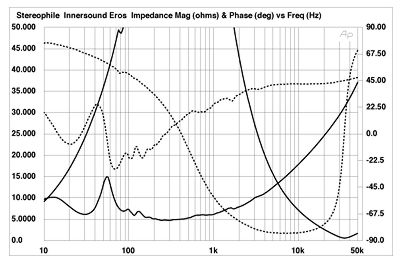
Fig.6 InnerSound Eros Mk.III, electrical impedance (solid) and phase (dashed) of electrostatic panel (top at 1kHz) and woofer. (5 ohms/vertical div.)
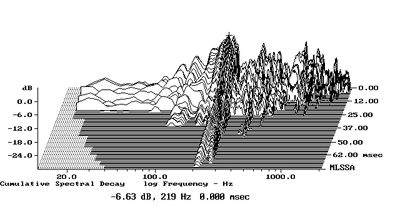
Fig.7 InnerSound Eros Mk.III, cumulative spectral-decay plot calculated from the output of an accelerometer fastened to the center of the woofer cabinet's side panel. (MLS driving voltage to speaker, 7.55V; measurement bandwidth, 2kHz.)
Fig.8 shows the farfield responses of the electrostatic panel (blue trace) and woofer (red above 350Hz), along with the nearfield woofer (red below 350Hz) and port (green) responses. (The crossover was in-circuit for all four measurements, with the Bass set to "6" and the Midrange to "90," which sounded most natural to my ears.)
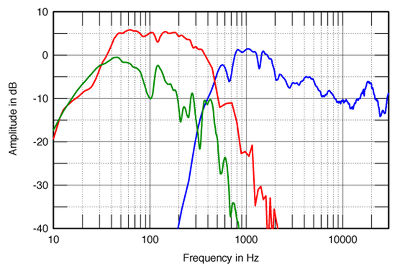
Fig.8 InnerSound Eros Mk.III, Midrange = "90," Bass = "6," anechoic response at 50" on mid-panel axis of electrostatic panel (blue trace) and woofer (red above 350Hz), both corrected for microphone response, with the nearfield responses of the woofer (red below 350Hz) and port (green).
- Log in or register to post comments




































